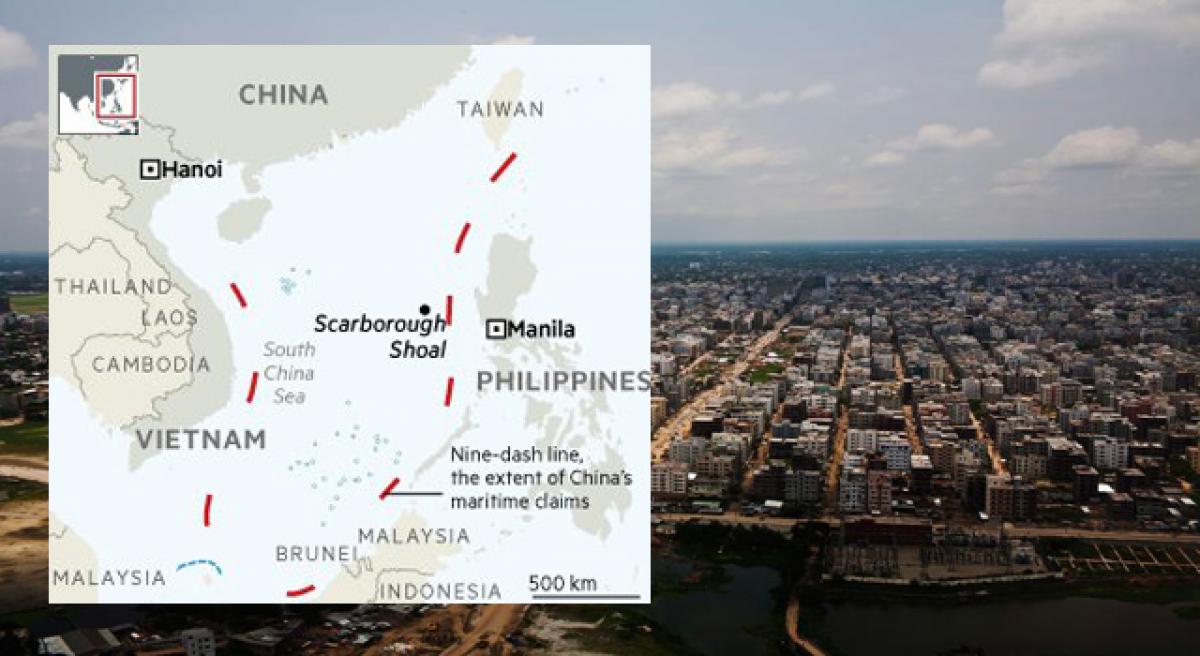Live
- AP Mega DSC Syllabus Released Ahead of issuance of Notification
- Exciting Future Space Missions by ISRO: Venus, Moon, Mars, Human Spaceflight, and More
- Space Station Safety Alert: Toxic Smell Detected After Russian Cargo Docking
- Protests in Tripura against Hindu priest's arrest in Bangladesh
- Sambhal miscreants being identified through CCTV, will face strict action: UP Minister
- Sambhal violence: Police release photos of rioters including three women
- AI-Enhanced HR Co-Pilot Max Sara 2.0 Rolled Out
- Hyderabad SBI Branch Prevents Senior Citizen from Falling Victim to Rs 13 Lakh Scam
- Maharashtra CM Post: Eknath Shinde's Plan B
- IPO-bound Senores Pharma, Dr. Reddy's Labs launch ivermectin tablets in US
Just In

A new GPS study of Bangladesh, India and Myanmar has found startling evidence that the north-eastern corner of the Indian subcontinent is actively colliding with Asia, potentially posing a major earthquake risk to one of the world’s most densely populated regions.
New York/Dhaka: A new GPS study of Bangladesh, India and Myanmar has found startling evidence that the north-eastern corner of the Indian subcontinent is actively colliding with Asia, potentially posing a major earthquake risk to one of the world’s most densely populated regions.
A magnitude of 9 earthquake that can turn urban areas in eastern India into “ruins” may be building beneath Bangladesh, warns the study. The study by the Columbia University was published in journal Nature Geoscience.
Scientists say they have new evidence of increasing strain where two tectonic plates underlie the world’s largest river delta –the Ganges-Brahmaputra delta
If researchers are right, a quake would probably turn urban areas in eastern India ‘into ruins,’ according to a seismologist
Scientists said they have new evidence of increasing strain where two tectonic plates underlie the world’s largest river delta. The researchers are not forecasting an imminent great earthquake but said it was an "under-appreciated hazard".
They estimate that at least 140 million people in the region could be affected if the boundary ruptures; the destruction could come not only from the direct results of shaking, but changes in the courses of great rivers, and in the level of land already perilously close to sea level.
The newly identified threat is a sub-duction zone, where one section of the earth’s crust, or a tectonic plate, is slowly thrusting under another. From 2003 to 2014, researchers led by geologist Michael Steckler of Columbia University’s Lamont-Doherty Earth Observatory installed and carefully monitored 26 GPS tracking stations across Bangladesh, to see how the country’s western half was moving relative to the Indian Peninsula.
When they combined their data with previous GPS studies done in northeast India and Myanmar, they determined that overall, Myanmar’s Shan Plateau is moving southwest at a rate of nearly 2 inches (51 millimetres) a year relative to the Indian Peninsula.
All of earth’s biggest known earthquakes occur along such zones; these include the Indian Ocean quake and tsunami that killed some 230,000 people in 2004, and the 2011 Tohoku quake and tsunami off Japan, which swept away more than 20,000 and caused the Fukushima nuclear disaster.
Up to now, all known such zones were only under the ocean; this one appears to be entirely under the land, which greatly multiplies the threat. The strain between the plates has been building for at least 400 years — the span of reliable historical records, which lack reports of any mega quake, said lead author Michael Steckler.
When an inevitable release comes, the shaking is likely to be larger than magnitude 8.2 and could even reach a magnitude of 9, similar to the largest known modern quakes, said Steckler. “Whether this region actually will slip in one single earthquake, nobody can say yes or no,” says Vineet Gahalaut, a geologist at India’s National Geophysical Research Institute and an expert on the region’s seismicity who wasn’t involved with the study. “We don’t have enough data to prove or disprove this.”
The rise of the Himalayas
A giant plate comprising India and much of the Indian Ocean has been thrusting northeasterly into Asia for tens of millions of years, researchers said. This collision has caused the Himalayas to rise to the north, bringing events like the 2015 Nepal quake that killed nearly 9,000 people.
Bangladesh and eastern India sit atop a landscape vulnerable even to moderate earthquakes: the vast delta of the Ganges and Brahmaputra rivers, researchers said. This is basically a pile of mud as deep as 12 miles, washed from the Himalayas to the coast, covering the sub-duction zone.
In a quake, this low-lying substrate would magnify the shaking like gelatin, and liquefy in many places, sucking in buildings, roads and people, said study co-author Syed Humayun Akhter, a geologist at Dhaka University.
“We don’t have a good idea of its geometry, we don’t know how far it goes down,” said James Ni, a seismologist at New Mexico State University. He said that if researchers are right, and the slab is building strain, a quake would probably turn urban areas in eastern India “into ruins,” and effects likely would extend into Myanmar and beyond.
Source: Agencies

© 2024 Hyderabad Media House Limited/The Hans India. All rights reserved. Powered by hocalwire.com







